Big Data Analysis: Techniques, Challenges, and Business Support Report
VerifiedAdded on 2022/12/27
|10
|2899
|32
Report
AI Summary
This report provides a comprehensive overview of big data analysis, beginning with an introduction to big data and its characteristics, including volume, velocity, variety, and veracity. It then delves into the challenges of big data analytics, such as data management uncertainty, lack of understanding, data growth, security concerns, integration difficulties, and gaining meaningful insights. The core of the report focuses on the techniques used to analyze big data, including A/B testing, regression analysis, data mining, R programming, and machine learning. Furthermore, it explores how big data technology supports businesses, using examples like Walmart's use of data mining for product personalization and Netflix's application of machine learning for customer targeting. The report concludes by summarizing the key findings and emphasizing the crucial role of big data analysis in various business entities, highlighting the need for expert management to overcome the associated challenges.
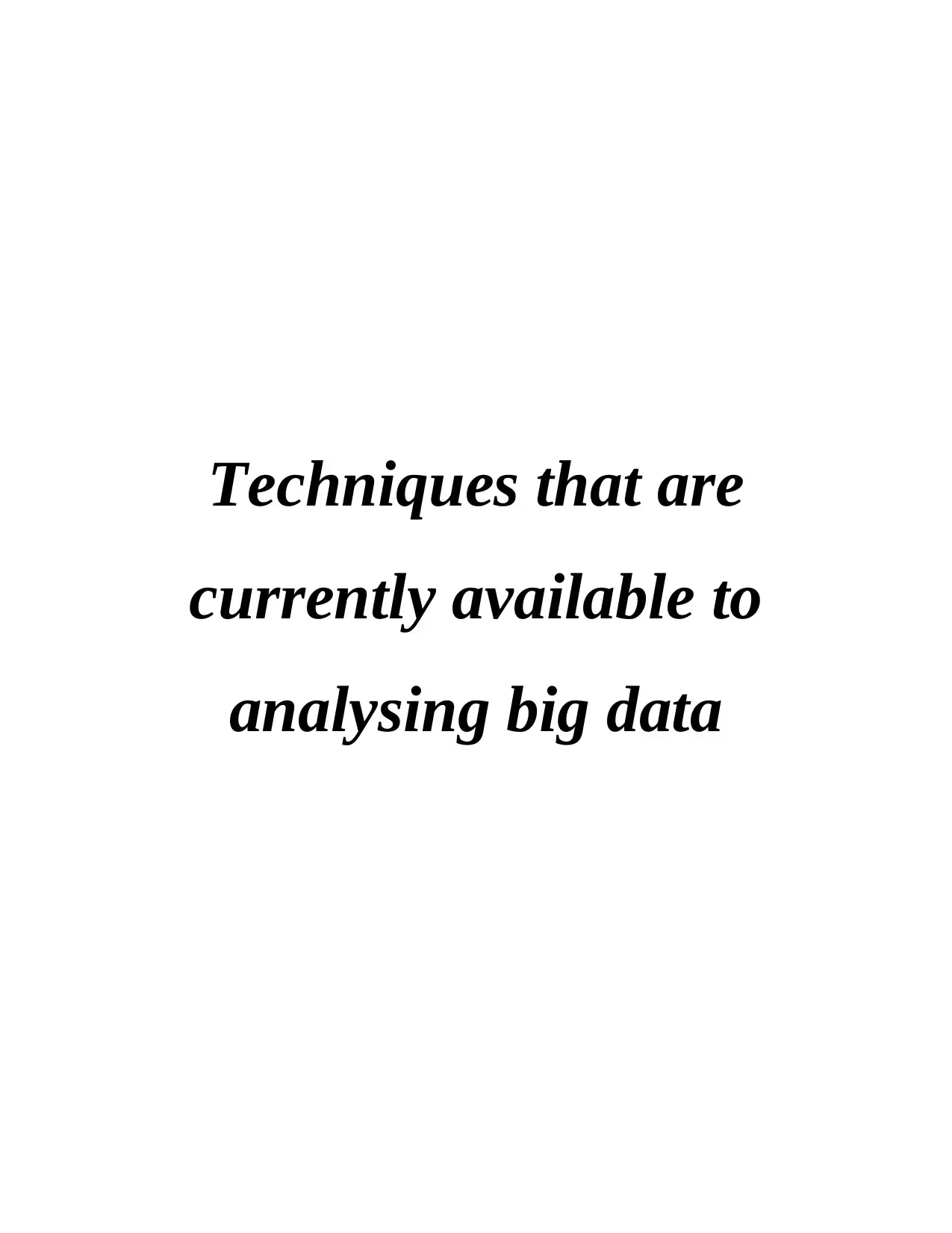
Techniques that are
currently available to
analysing big data
currently available to
analysing big data
Paraphrase This Document
Need a fresh take? Get an instant paraphrase of this document with our AI Paraphraser
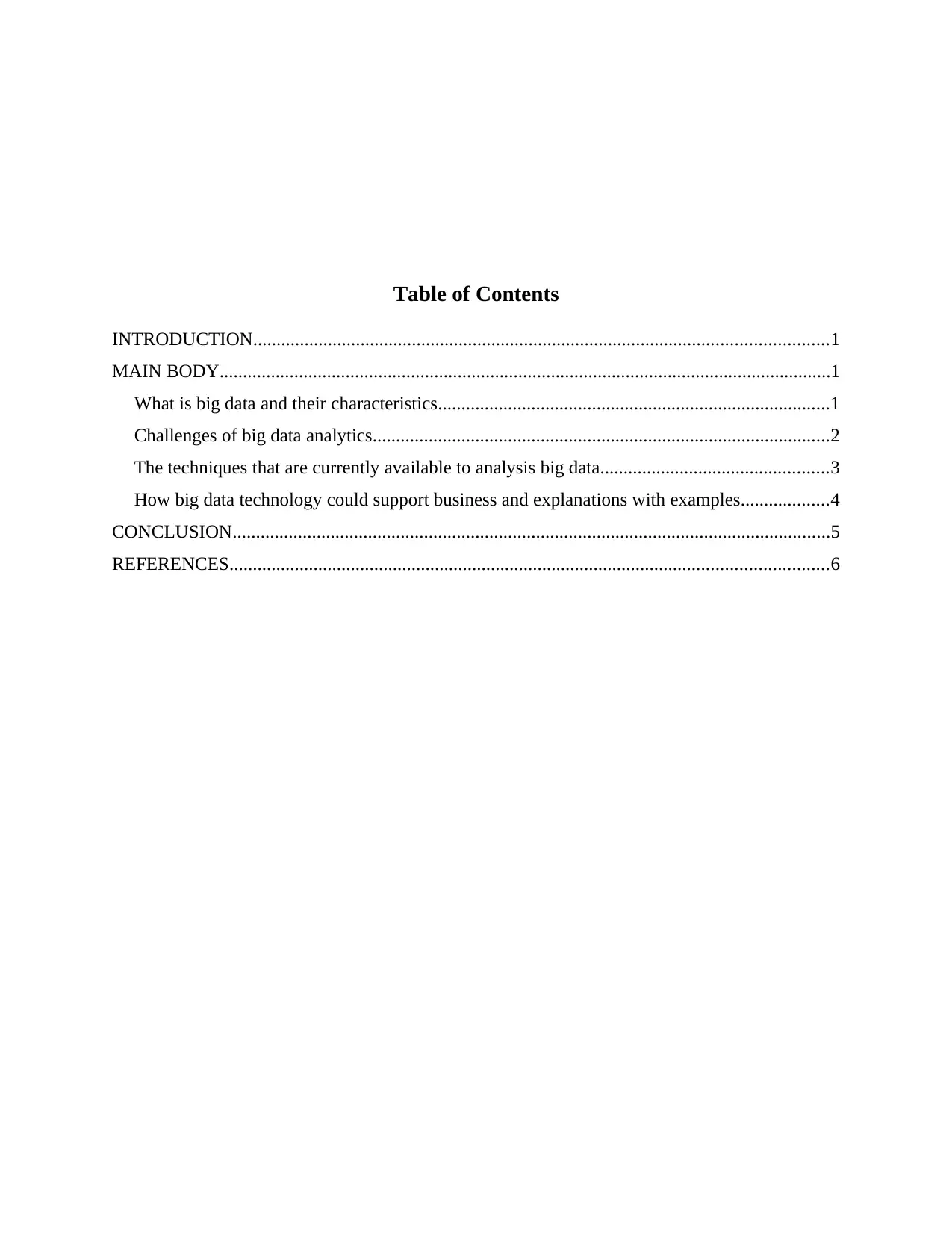
Table of Contents
INTRODUCTION...........................................................................................................................1
MAIN BODY...................................................................................................................................1
What is big data and their characteristics....................................................................................1
Challenges of big data analytics..................................................................................................2
The techniques that are currently available to analysis big data.................................................3
How big data technology could support business and explanations with examples...................4
CONCLUSION................................................................................................................................5
REFERENCES................................................................................................................................6
INTRODUCTION...........................................................................................................................1
MAIN BODY...................................................................................................................................1
What is big data and their characteristics....................................................................................1
Challenges of big data analytics..................................................................................................2
The techniques that are currently available to analysis big data.................................................3
How big data technology could support business and explanations with examples...................4
CONCLUSION................................................................................................................................5
REFERENCES................................................................................................................................6
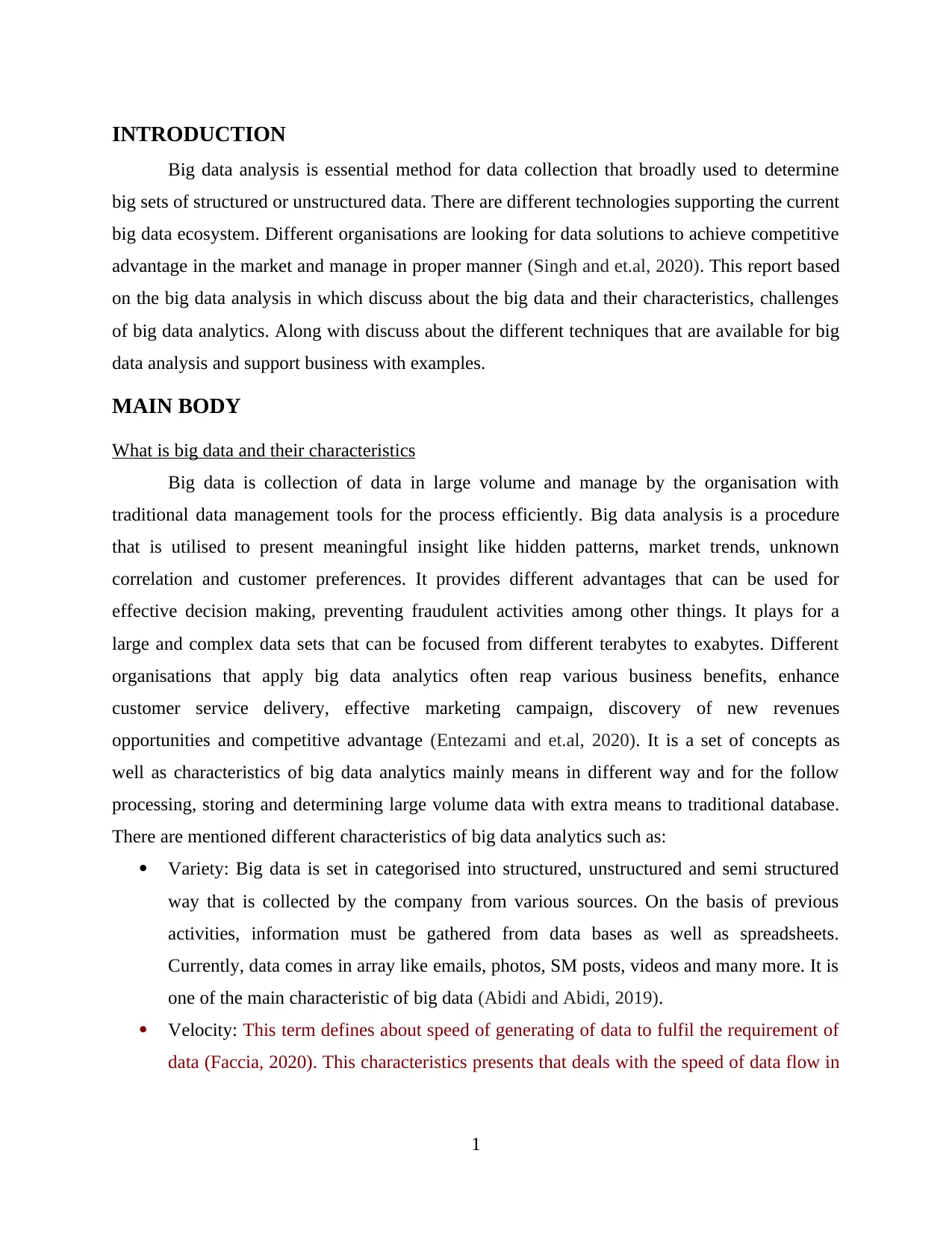
INTRODUCTION
Big data analysis is essential method for data collection that broadly used to determine
big sets of structured or unstructured data. There are different technologies supporting the current
big data ecosystem. Different organisations are looking for data solutions to achieve competitive
advantage in the market and manage in proper manner (Singh and et.al, 2020). This report based
on the big data analysis in which discuss about the big data and their characteristics, challenges
of big data analytics. Along with discuss about the different techniques that are available for big
data analysis and support business with examples.
MAIN BODY
What is big data and their characteristics
Big data is collection of data in large volume and manage by the organisation with
traditional data management tools for the process efficiently. Big data analysis is a procedure
that is utilised to present meaningful insight like hidden patterns, market trends, unknown
correlation and customer preferences. It provides different advantages that can be used for
effective decision making, preventing fraudulent activities among other things. It plays for a
large and complex data sets that can be focused from different terabytes to exabytes. Different
organisations that apply big data analytics often reap various business benefits, enhance
customer service delivery, effective marketing campaign, discovery of new revenues
opportunities and competitive advantage (Entezami and et.al, 2020). It is a set of concepts as
well as characteristics of big data analytics mainly means in different way and for the follow
processing, storing and determining large volume data with extra means to traditional database.
There are mentioned different characteristics of big data analytics such as:
Variety: Big data is set in categorised into structured, unstructured and semi structured
way that is collected by the company from various sources. On the basis of previous
activities, information must be gathered from data bases as well as spreadsheets.
Currently, data comes in array like emails, photos, SM posts, videos and many more. It is
one of the main characteristic of big data (Abidi and Abidi, 2019).
Velocity: This term defines about speed of generating of data to fulfil the requirement of
data (Faccia, 2020). This characteristics presents that deals with the speed of data flow in
1
Big data analysis is essential method for data collection that broadly used to determine
big sets of structured or unstructured data. There are different technologies supporting the current
big data ecosystem. Different organisations are looking for data solutions to achieve competitive
advantage in the market and manage in proper manner (Singh and et.al, 2020). This report based
on the big data analysis in which discuss about the big data and their characteristics, challenges
of big data analytics. Along with discuss about the different techniques that are available for big
data analysis and support business with examples.
MAIN BODY
What is big data and their characteristics
Big data is collection of data in large volume and manage by the organisation with
traditional data management tools for the process efficiently. Big data analysis is a procedure
that is utilised to present meaningful insight like hidden patterns, market trends, unknown
correlation and customer preferences. It provides different advantages that can be used for
effective decision making, preventing fraudulent activities among other things. It plays for a
large and complex data sets that can be focused from different terabytes to exabytes. Different
organisations that apply big data analytics often reap various business benefits, enhance
customer service delivery, effective marketing campaign, discovery of new revenues
opportunities and competitive advantage (Entezami and et.al, 2020). It is a set of concepts as
well as characteristics of big data analytics mainly means in different way and for the follow
processing, storing and determining large volume data with extra means to traditional database.
There are mentioned different characteristics of big data analytics such as:
Variety: Big data is set in categorised into structured, unstructured and semi structured
way that is collected by the company from various sources. On the basis of previous
activities, information must be gathered from data bases as well as spreadsheets.
Currently, data comes in array like emails, photos, SM posts, videos and many more. It is
one of the main characteristic of big data (Abidi and Abidi, 2019).
Velocity: This term defines about speed of generating of data to fulfil the requirement of
data (Faccia, 2020). This characteristics presents that deals with the speed of data flow in
1
⊘ This is a preview!⊘
Do you want full access?
Subscribe today to unlock all pages.

Trusted by 1+ million students worldwide
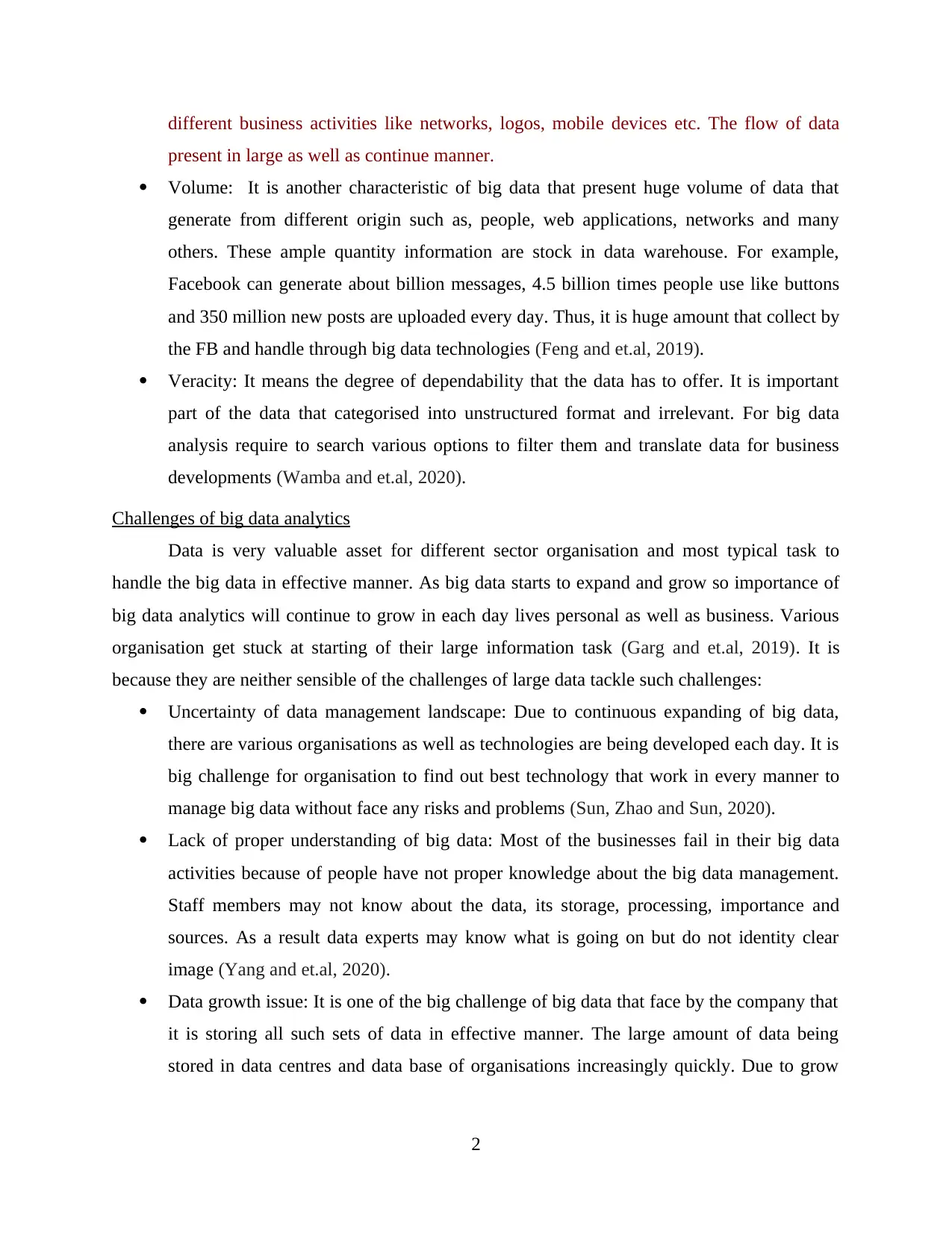
different business activities like networks, logos, mobile devices etc. The flow of data
present in large as well as continue manner.
Volume: It is another characteristic of big data that present huge volume of data that
generate from different origin such as, people, web applications, networks and many
others. These ample quantity information are stock in data warehouse. For example,
Facebook can generate about billion messages, 4.5 billion times people use like buttons
and 350 million new posts are uploaded every day. Thus, it is huge amount that collect by
the FB and handle through big data technologies (Feng and et.al, 2019).
Veracity: It means the degree of dependability that the data has to offer. It is important
part of the data that categorised into unstructured format and irrelevant. For big data
analysis require to search various options to filter them and translate data for business
developments (Wamba and et.al, 2020).
Challenges of big data analytics
Data is very valuable asset for different sector organisation and most typical task to
handle the big data in effective manner. As big data starts to expand and grow so importance of
big data analytics will continue to grow in each day lives personal as well as business. Various
organisation get stuck at starting of their large information task (Garg and et.al, 2019). It is
because they are neither sensible of the challenges of large data tackle such challenges:
Uncertainty of data management landscape: Due to continuous expanding of big data,
there are various organisations as well as technologies are being developed each day. It is
big challenge for organisation to find out best technology that work in every manner to
manage big data without face any risks and problems (Sun, Zhao and Sun, 2020).
Lack of proper understanding of big data: Most of the businesses fail in their big data
activities because of people have not proper knowledge about the big data management.
Staff members may not know about the data, its storage, processing, importance and
sources. As a result data experts may know what is going on but do not identity clear
image (Yang and et.al, 2020).
Data growth issue: It is one of the big challenge of big data that face by the company that
it is storing all such sets of data in effective manner. The large amount of data being
stored in data centres and data base of organisations increasingly quickly. Due to grow
2
present in large as well as continue manner.
Volume: It is another characteristic of big data that present huge volume of data that
generate from different origin such as, people, web applications, networks and many
others. These ample quantity information are stock in data warehouse. For example,
Facebook can generate about billion messages, 4.5 billion times people use like buttons
and 350 million new posts are uploaded every day. Thus, it is huge amount that collect by
the FB and handle through big data technologies (Feng and et.al, 2019).
Veracity: It means the degree of dependability that the data has to offer. It is important
part of the data that categorised into unstructured format and irrelevant. For big data
analysis require to search various options to filter them and translate data for business
developments (Wamba and et.al, 2020).
Challenges of big data analytics
Data is very valuable asset for different sector organisation and most typical task to
handle the big data in effective manner. As big data starts to expand and grow so importance of
big data analytics will continue to grow in each day lives personal as well as business. Various
organisation get stuck at starting of their large information task (Garg and et.al, 2019). It is
because they are neither sensible of the challenges of large data tackle such challenges:
Uncertainty of data management landscape: Due to continuous expanding of big data,
there are various organisations as well as technologies are being developed each day. It is
big challenge for organisation to find out best technology that work in every manner to
manage big data without face any risks and problems (Sun, Zhao and Sun, 2020).
Lack of proper understanding of big data: Most of the businesses fail in their big data
activities because of people have not proper knowledge about the big data management.
Staff members may not know about the data, its storage, processing, importance and
sources. As a result data experts may know what is going on but do not identity clear
image (Yang and et.al, 2020).
Data growth issue: It is one of the big challenge of big data that face by the company that
it is storing all such sets of data in effective manner. The large amount of data being
stored in data centres and data base of organisations increasingly quickly. Due to grow
2
Paraphrase This Document
Need a fresh take? Get an instant paraphrase of this document with our AI Paraphraser
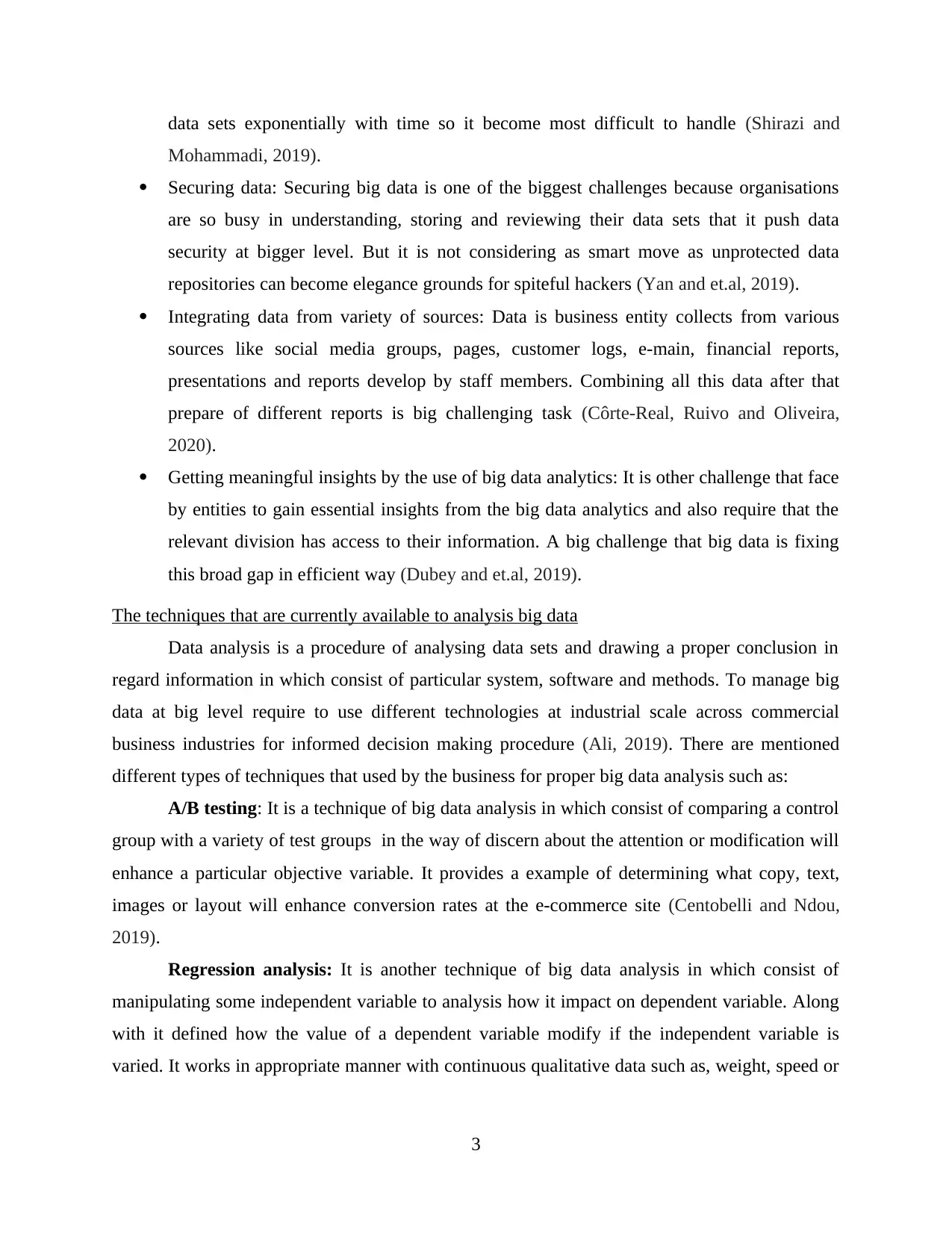
data sets exponentially with time so it become most difficult to handle (Shirazi and
Mohammadi, 2019).
Securing data: Securing big data is one of the biggest challenges because organisations
are so busy in understanding, storing and reviewing their data sets that it push data
security at bigger level. But it is not considering as smart move as unprotected data
repositories can become elegance grounds for spiteful hackers (Yan and et.al, 2019).
Integrating data from variety of sources: Data is business entity collects from various
sources like social media groups, pages, customer logs, e-main, financial reports,
presentations and reports develop by staff members. Combining all this data after that
prepare of different reports is big challenging task (Côrte-Real, Ruivo and Oliveira,
2020).
Getting meaningful insights by the use of big data analytics: It is other challenge that face
by entities to gain essential insights from the big data analytics and also require that the
relevant division has access to their information. A big challenge that big data is fixing
this broad gap in efficient way (Dubey and et.al, 2019).
The techniques that are currently available to analysis big data
Data analysis is a procedure of analysing data sets and drawing a proper conclusion in
regard information in which consist of particular system, software and methods. To manage big
data at big level require to use different technologies at industrial scale across commercial
business industries for informed decision making procedure (Ali, 2019). There are mentioned
different types of techniques that used by the business for proper big data analysis such as:
A/B testing: It is a technique of big data analysis in which consist of comparing a control
group with a variety of test groups in the way of discern about the attention or modification will
enhance a particular objective variable. It provides a example of determining what copy, text,
images or layout will enhance conversion rates at the e-commerce site (Centobelli and Ndou,
2019).
Regression analysis: It is another technique of big data analysis in which consist of
manipulating some independent variable to analysis how it impact on dependent variable. Along
with it defined how the value of a dependent variable modify if the independent variable is
varied. It works in appropriate manner with continuous qualitative data such as, weight, speed or
3
Mohammadi, 2019).
Securing data: Securing big data is one of the biggest challenges because organisations
are so busy in understanding, storing and reviewing their data sets that it push data
security at bigger level. But it is not considering as smart move as unprotected data
repositories can become elegance grounds for spiteful hackers (Yan and et.al, 2019).
Integrating data from variety of sources: Data is business entity collects from various
sources like social media groups, pages, customer logs, e-main, financial reports,
presentations and reports develop by staff members. Combining all this data after that
prepare of different reports is big challenging task (Côrte-Real, Ruivo and Oliveira,
2020).
Getting meaningful insights by the use of big data analytics: It is other challenge that face
by entities to gain essential insights from the big data analytics and also require that the
relevant division has access to their information. A big challenge that big data is fixing
this broad gap in efficient way (Dubey and et.al, 2019).
The techniques that are currently available to analysis big data
Data analysis is a procedure of analysing data sets and drawing a proper conclusion in
regard information in which consist of particular system, software and methods. To manage big
data at big level require to use different technologies at industrial scale across commercial
business industries for informed decision making procedure (Ali, 2019). There are mentioned
different types of techniques that used by the business for proper big data analysis such as:
A/B testing: It is a technique of big data analysis in which consist of comparing a control
group with a variety of test groups in the way of discern about the attention or modification will
enhance a particular objective variable. It provides a example of determining what copy, text,
images or layout will enhance conversion rates at the e-commerce site (Centobelli and Ndou,
2019).
Regression analysis: It is another technique of big data analysis in which consist of
manipulating some independent variable to analysis how it impact on dependent variable. Along
with it defined how the value of a dependent variable modify if the independent variable is
varied. It works in appropriate manner with continuous qualitative data such as, weight, speed or
3
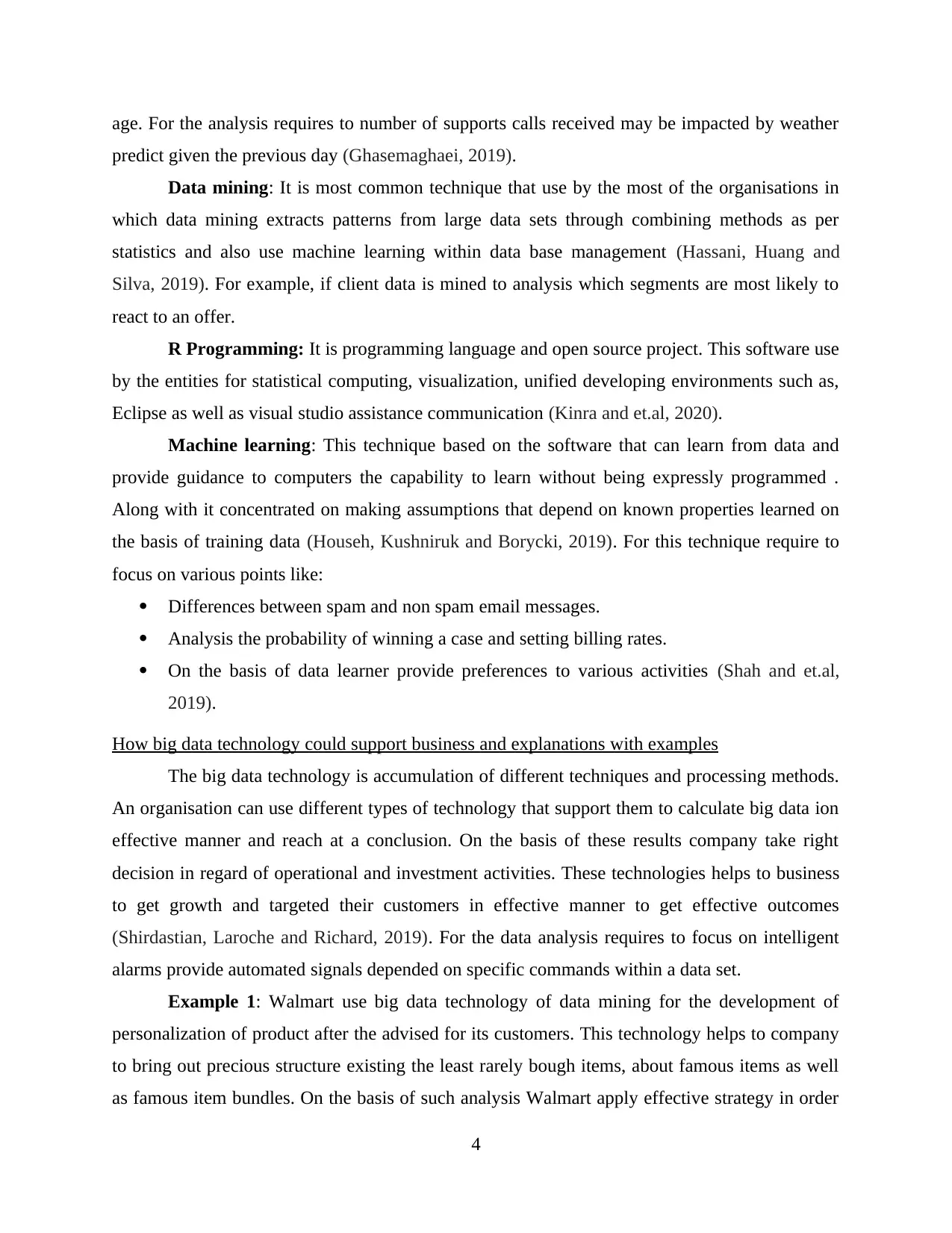
age. For the analysis requires to number of supports calls received may be impacted by weather
predict given the previous day (Ghasemaghaei, 2019).
Data mining: It is most common technique that use by the most of the organisations in
which data mining extracts patterns from large data sets through combining methods as per
statistics and also use machine learning within data base management (Hassani, Huang and
Silva, 2019). For example, if client data is mined to analysis which segments are most likely to
react to an offer.
R Programming: It is programming language and open source project. This software use
by the entities for statistical computing, visualization, unified developing environments such as,
Eclipse as well as visual studio assistance communication (Kinra and et.al, 2020).
Machine learning: This technique based on the software that can learn from data and
provide guidance to computers the capability to learn without being expressly programmed .
Along with it concentrated on making assumptions that depend on known properties learned on
the basis of training data (Househ, Kushniruk and Borycki, 2019). For this technique require to
focus on various points like:
Differences between spam and non spam email messages.
Analysis the probability of winning a case and setting billing rates.
On the basis of data learner provide preferences to various activities (Shah and et.al,
2019).
How big data technology could support business and explanations with examples
The big data technology is accumulation of different techniques and processing methods.
An organisation can use different types of technology that support them to calculate big data ion
effective manner and reach at a conclusion. On the basis of these results company take right
decision in regard of operational and investment activities. These technologies helps to business
to get growth and targeted their customers in effective manner to get effective outcomes
(Shirdastian, Laroche and Richard, 2019). For the data analysis requires to focus on intelligent
alarms provide automated signals depended on specific commands within a data set.
Example 1: Walmart use big data technology of data mining for the development of
personalization of product after the advised for its customers. This technology helps to company
to bring out precious structure existing the least rarely bough items, about famous items as well
as famous item bundles. On the basis of such analysis Walmart apply effective strategy in order
4
predict given the previous day (Ghasemaghaei, 2019).
Data mining: It is most common technique that use by the most of the organisations in
which data mining extracts patterns from large data sets through combining methods as per
statistics and also use machine learning within data base management (Hassani, Huang and
Silva, 2019). For example, if client data is mined to analysis which segments are most likely to
react to an offer.
R Programming: It is programming language and open source project. This software use
by the entities for statistical computing, visualization, unified developing environments such as,
Eclipse as well as visual studio assistance communication (Kinra and et.al, 2020).
Machine learning: This technique based on the software that can learn from data and
provide guidance to computers the capability to learn without being expressly programmed .
Along with it concentrated on making assumptions that depend on known properties learned on
the basis of training data (Househ, Kushniruk and Borycki, 2019). For this technique require to
focus on various points like:
Differences between spam and non spam email messages.
Analysis the probability of winning a case and setting billing rates.
On the basis of data learner provide preferences to various activities (Shah and et.al,
2019).
How big data technology could support business and explanations with examples
The big data technology is accumulation of different techniques and processing methods.
An organisation can use different types of technology that support them to calculate big data ion
effective manner and reach at a conclusion. On the basis of these results company take right
decision in regard of operational and investment activities. These technologies helps to business
to get growth and targeted their customers in effective manner to get effective outcomes
(Shirdastian, Laroche and Richard, 2019). For the data analysis requires to focus on intelligent
alarms provide automated signals depended on specific commands within a data set.
Example 1: Walmart use big data technology of data mining for the development of
personalization of product after the advised for its customers. This technology helps to company
to bring out precious structure existing the least rarely bough items, about famous items as well
as famous item bundles. On the basis of such analysis Walmart apply effective strategy in order
4
⊘ This is a preview!⊘
Do you want full access?
Subscribe today to unlock all pages.

Trusted by 1+ million students worldwide
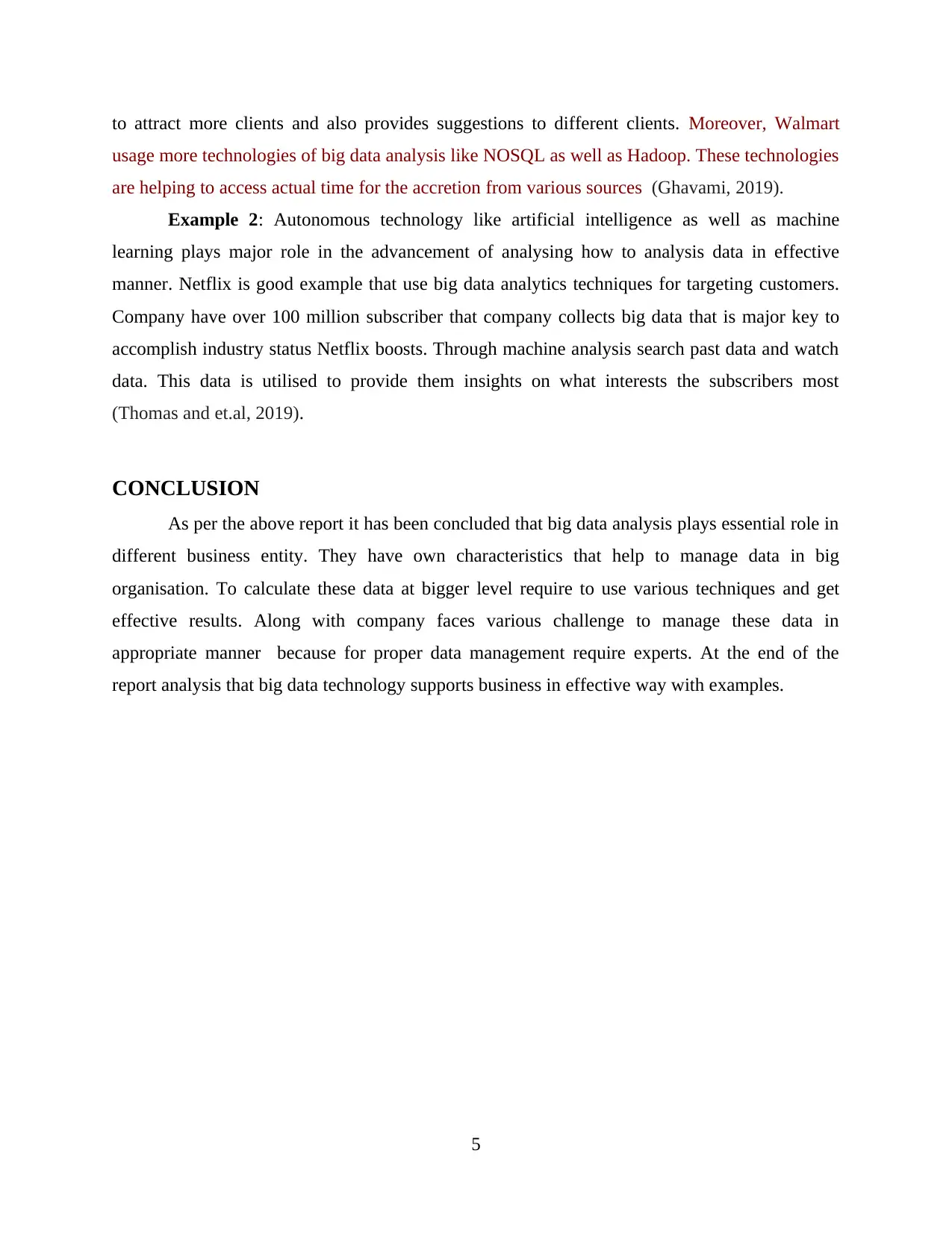
to attract more clients and also provides suggestions to different clients. Moreover, Walmart
usage more technologies of big data analysis like NOSQL as well as Hadoop. These technologies
are helping to access actual time for the accretion from various sources (Ghavami, 2019).
Example 2: Autonomous technology like artificial intelligence as well as machine
learning plays major role in the advancement of analysing how to analysis data in effective
manner. Netflix is good example that use big data analytics techniques for targeting customers.
Company have over 100 million subscriber that company collects big data that is major key to
accomplish industry status Netflix boosts. Through machine analysis search past data and watch
data. This data is utilised to provide them insights on what interests the subscribers most
(Thomas and et.al, 2019).
CONCLUSION
As per the above report it has been concluded that big data analysis plays essential role in
different business entity. They have own characteristics that help to manage data in big
organisation. To calculate these data at bigger level require to use various techniques and get
effective results. Along with company faces various challenge to manage these data in
appropriate manner because for proper data management require experts. At the end of the
report analysis that big data technology supports business in effective way with examples.
5
usage more technologies of big data analysis like NOSQL as well as Hadoop. These technologies
are helping to access actual time for the accretion from various sources (Ghavami, 2019).
Example 2: Autonomous technology like artificial intelligence as well as machine
learning plays major role in the advancement of analysing how to analysis data in effective
manner. Netflix is good example that use big data analytics techniques for targeting customers.
Company have over 100 million subscriber that company collects big data that is major key to
accomplish industry status Netflix boosts. Through machine analysis search past data and watch
data. This data is utilised to provide them insights on what interests the subscribers most
(Thomas and et.al, 2019).
CONCLUSION
As per the above report it has been concluded that big data analysis plays essential role in
different business entity. They have own characteristics that help to manage data in big
organisation. To calculate these data at bigger level require to use various techniques and get
effective results. Along with company faces various challenge to manage these data in
appropriate manner because for proper data management require experts. At the end of the
report analysis that big data technology supports business in effective way with examples.
5
Paraphrase This Document
Need a fresh take? Get an instant paraphrase of this document with our AI Paraphraser

6
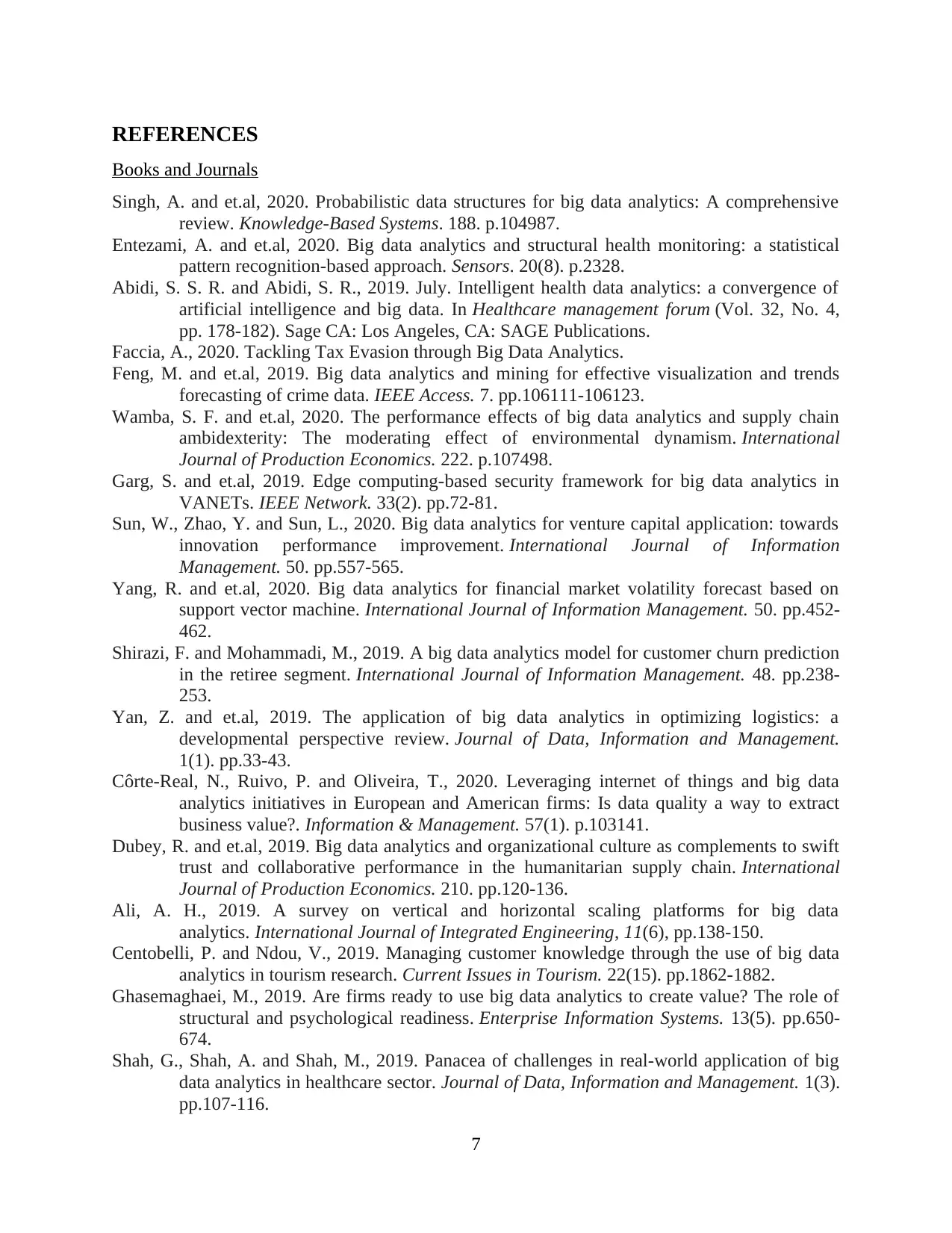
REFERENCES
Books and Journals
Singh, A. and et.al, 2020. Probabilistic data structures for big data analytics: A comprehensive
review. Knowledge-Based Systems. 188. p.104987.
Entezami, A. and et.al, 2020. Big data analytics and structural health monitoring: a statistical
pattern recognition-based approach. Sensors. 20(8). p.2328.
Abidi, S. S. R. and Abidi, S. R., 2019. July. Intelligent health data analytics: a convergence of
artificial intelligence and big data. In Healthcare management forum (Vol. 32, No. 4,
pp. 178-182). Sage CA: Los Angeles, CA: SAGE Publications.
Faccia, A., 2020. Tackling Tax Evasion through Big Data Analytics.
Feng, M. and et.al, 2019. Big data analytics and mining for effective visualization and trends
forecasting of crime data. IEEE Access. 7. pp.106111-106123.
Wamba, S. F. and et.al, 2020. The performance effects of big data analytics and supply chain
ambidexterity: The moderating effect of environmental dynamism. International
Journal of Production Economics. 222. p.107498.
Garg, S. and et.al, 2019. Edge computing-based security framework for big data analytics in
VANETs. IEEE Network. 33(2). pp.72-81.
Sun, W., Zhao, Y. and Sun, L., 2020. Big data analytics for venture capital application: towards
innovation performance improvement. International Journal of Information
Management. 50. pp.557-565.
Yang, R. and et.al, 2020. Big data analytics for financial market volatility forecast based on
support vector machine. International Journal of Information Management. 50. pp.452-
462.
Shirazi, F. and Mohammadi, M., 2019. A big data analytics model for customer churn prediction
in the retiree segment. International Journal of Information Management. 48. pp.238-
253.
Yan, Z. and et.al, 2019. The application of big data analytics in optimizing logistics: a
developmental perspective review. Journal of Data, Information and Management.
1(1). pp.33-43.
Côrte-Real, N., Ruivo, P. and Oliveira, T., 2020. Leveraging internet of things and big data
analytics initiatives in European and American firms: Is data quality a way to extract
business value?. Information & Management. 57(1). p.103141.
Dubey, R. and et.al, 2019. Big data analytics and organizational culture as complements to swift
trust and collaborative performance in the humanitarian supply chain. International
Journal of Production Economics. 210. pp.120-136.
Ali, A. H., 2019. A survey on vertical and horizontal scaling platforms for big data
analytics. International Journal of Integrated Engineering, 11(6), pp.138-150.
Centobelli, P. and Ndou, V., 2019. Managing customer knowledge through the use of big data
analytics in tourism research. Current Issues in Tourism. 22(15). pp.1862-1882.
Ghasemaghaei, M., 2019. Are firms ready to use big data analytics to create value? The role of
structural and psychological readiness. Enterprise Information Systems. 13(5). pp.650-
674.
Shah, G., Shah, A. and Shah, M., 2019. Panacea of challenges in real-world application of big
data analytics in healthcare sector. Journal of Data, Information and Management. 1(3).
pp.107-116.
7
Books and Journals
Singh, A. and et.al, 2020. Probabilistic data structures for big data analytics: A comprehensive
review. Knowledge-Based Systems. 188. p.104987.
Entezami, A. and et.al, 2020. Big data analytics and structural health monitoring: a statistical
pattern recognition-based approach. Sensors. 20(8). p.2328.
Abidi, S. S. R. and Abidi, S. R., 2019. July. Intelligent health data analytics: a convergence of
artificial intelligence and big data. In Healthcare management forum (Vol. 32, No. 4,
pp. 178-182). Sage CA: Los Angeles, CA: SAGE Publications.
Faccia, A., 2020. Tackling Tax Evasion through Big Data Analytics.
Feng, M. and et.al, 2019. Big data analytics and mining for effective visualization and trends
forecasting of crime data. IEEE Access. 7. pp.106111-106123.
Wamba, S. F. and et.al, 2020. The performance effects of big data analytics and supply chain
ambidexterity: The moderating effect of environmental dynamism. International
Journal of Production Economics. 222. p.107498.
Garg, S. and et.al, 2019. Edge computing-based security framework for big data analytics in
VANETs. IEEE Network. 33(2). pp.72-81.
Sun, W., Zhao, Y. and Sun, L., 2020. Big data analytics for venture capital application: towards
innovation performance improvement. International Journal of Information
Management. 50. pp.557-565.
Yang, R. and et.al, 2020. Big data analytics for financial market volatility forecast based on
support vector machine. International Journal of Information Management. 50. pp.452-
462.
Shirazi, F. and Mohammadi, M., 2019. A big data analytics model for customer churn prediction
in the retiree segment. International Journal of Information Management. 48. pp.238-
253.
Yan, Z. and et.al, 2019. The application of big data analytics in optimizing logistics: a
developmental perspective review. Journal of Data, Information and Management.
1(1). pp.33-43.
Côrte-Real, N., Ruivo, P. and Oliveira, T., 2020. Leveraging internet of things and big data
analytics initiatives in European and American firms: Is data quality a way to extract
business value?. Information & Management. 57(1). p.103141.
Dubey, R. and et.al, 2019. Big data analytics and organizational culture as complements to swift
trust and collaborative performance in the humanitarian supply chain. International
Journal of Production Economics. 210. pp.120-136.
Ali, A. H., 2019. A survey on vertical and horizontal scaling platforms for big data
analytics. International Journal of Integrated Engineering, 11(6), pp.138-150.
Centobelli, P. and Ndou, V., 2019. Managing customer knowledge through the use of big data
analytics in tourism research. Current Issues in Tourism. 22(15). pp.1862-1882.
Ghasemaghaei, M., 2019. Are firms ready to use big data analytics to create value? The role of
structural and psychological readiness. Enterprise Information Systems. 13(5). pp.650-
674.
Shah, G., Shah, A. and Shah, M., 2019. Panacea of challenges in real-world application of big
data analytics in healthcare sector. Journal of Data, Information and Management. 1(3).
pp.107-116.
7
⊘ This is a preview!⊘
Do you want full access?
Subscribe today to unlock all pages.

Trusted by 1+ million students worldwide
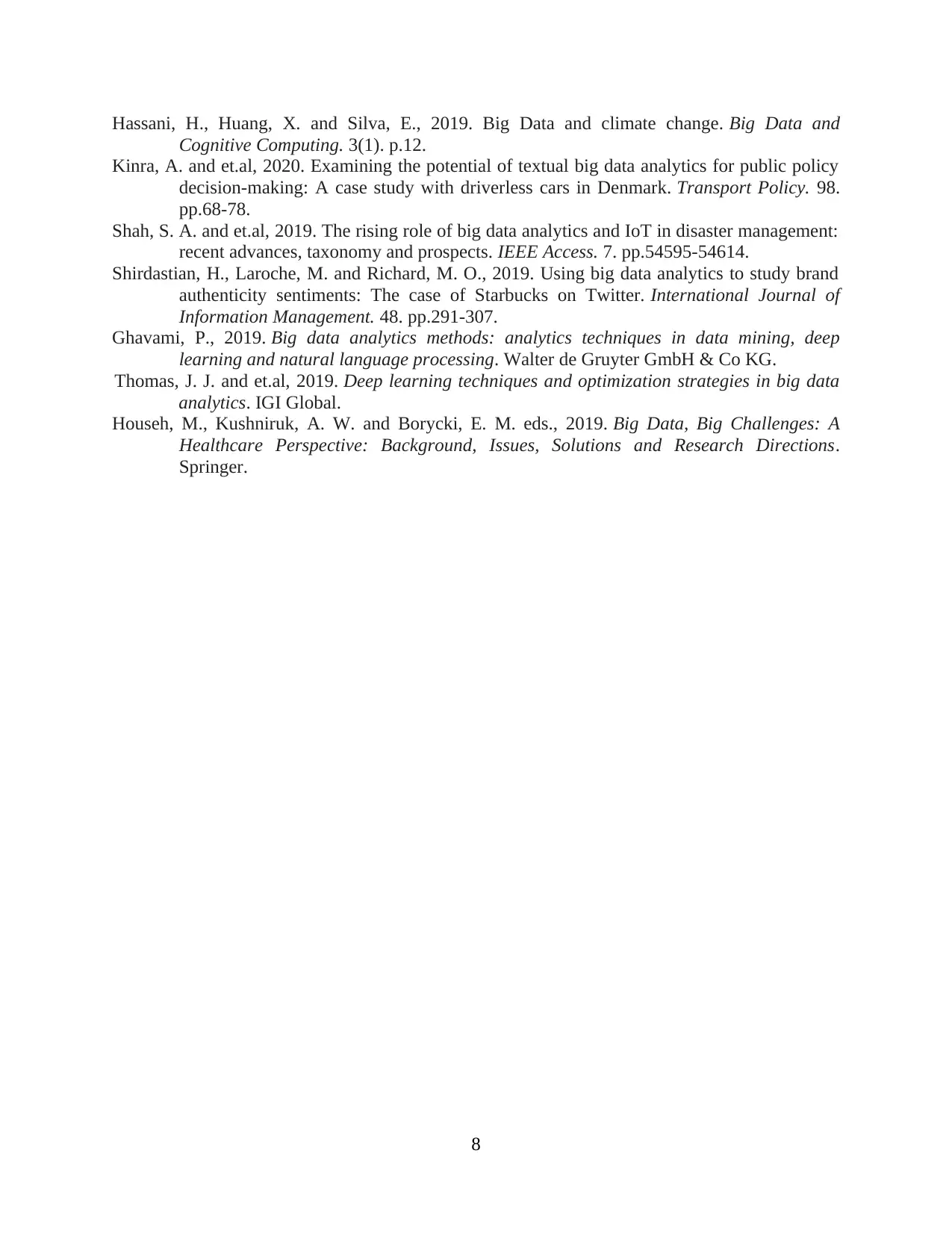
Hassani, H., Huang, X. and Silva, E., 2019. Big Data and climate change. Big Data and
Cognitive Computing. 3(1). p.12.
Kinra, A. and et.al, 2020. Examining the potential of textual big data analytics for public policy
decision-making: A case study with driverless cars in Denmark. Transport Policy. 98.
pp.68-78.
Shah, S. A. and et.al, 2019. The rising role of big data analytics and IoT in disaster management:
recent advances, taxonomy and prospects. IEEE Access. 7. pp.54595-54614.
Shirdastian, H., Laroche, M. and Richard, M. O., 2019. Using big data analytics to study brand
authenticity sentiments: The case of Starbucks on Twitter. International Journal of
Information Management. 48. pp.291-307.
Ghavami, P., 2019. Big data analytics methods: analytics techniques in data mining, deep
learning and natural language processing. Walter de Gruyter GmbH & Co KG.
Thomas, J. J. and et.al, 2019. Deep learning techniques and optimization strategies in big data
analytics. IGI Global.
Househ, M., Kushniruk, A. W. and Borycki, E. M. eds., 2019. Big Data, Big Challenges: A
Healthcare Perspective: Background, Issues, Solutions and Research Directions.
Springer.
8
Cognitive Computing. 3(1). p.12.
Kinra, A. and et.al, 2020. Examining the potential of textual big data analytics for public policy
decision-making: A case study with driverless cars in Denmark. Transport Policy. 98.
pp.68-78.
Shah, S. A. and et.al, 2019. The rising role of big data analytics and IoT in disaster management:
recent advances, taxonomy and prospects. IEEE Access. 7. pp.54595-54614.
Shirdastian, H., Laroche, M. and Richard, M. O., 2019. Using big data analytics to study brand
authenticity sentiments: The case of Starbucks on Twitter. International Journal of
Information Management. 48. pp.291-307.
Ghavami, P., 2019. Big data analytics methods: analytics techniques in data mining, deep
learning and natural language processing. Walter de Gruyter GmbH & Co KG.
Thomas, J. J. and et.al, 2019. Deep learning techniques and optimization strategies in big data
analytics. IGI Global.
Househ, M., Kushniruk, A. W. and Borycki, E. M. eds., 2019. Big Data, Big Challenges: A
Healthcare Perspective: Background, Issues, Solutions and Research Directions.
Springer.
8
1 out of 10
Related Documents
Your All-in-One AI-Powered Toolkit for Academic Success.
+13062052269
info@desklib.com
Available 24*7 on WhatsApp / Email
![[object Object]](/_next/static/media/star-bottom.7253800d.svg)
Unlock your academic potential
Copyright © 2020–2025 A2Z Services. All Rights Reserved. Developed and managed by ZUCOL.


